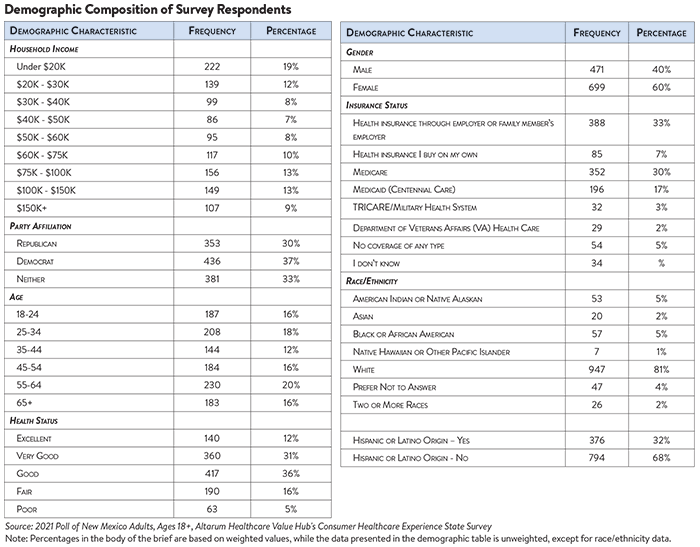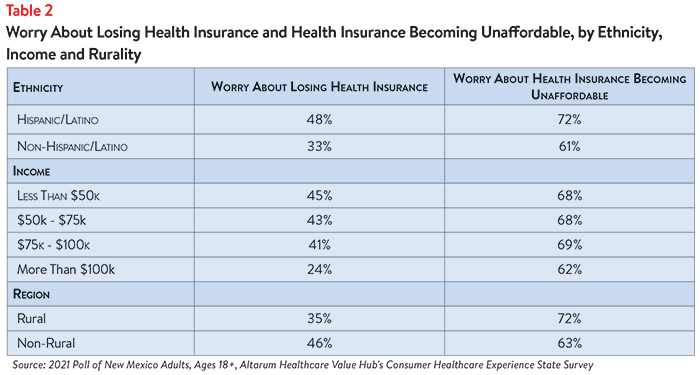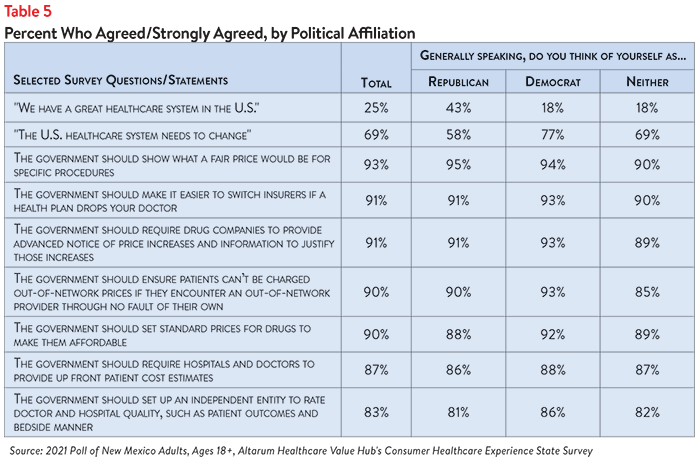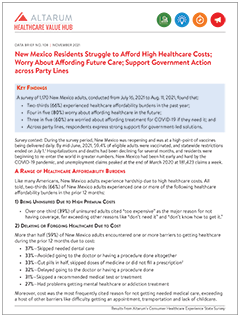New Mexico Residents Struggle to Afford High Healthcare Costs; Worry About Affording Future Care; Support Government Action across Party Lines
Key Findings
A survey of 1,170 New Mexico adults, conducted from July 16, 2021 to Aug. 11, 2021, found that:
- Two-thirds (66%) experienced healthcare affordability burdens in the past year;
- Four in five (80%) worry about affording healthcare in the future;
- Three in five (60%) are worried about affording treatment for COVID-19 if they need it; and
- Across party lines, respondents express strong support for government-led solutions.
Survey context: During the survey period, New Mexico was reopening and was at a high-point of vaccines being delivered daily. By mid-June, 2021, 59.4% of eligible adults were vaccinated, and statewide restrictions ended on July 1.1 Hospitalizations and deaths had been declining for several months, and residents were beginning to re-enter the world in greater numbers. New Mexico had been hit early and hard by the COVID-19 pandemic, and unemployment claims peaked at the end of March 2020 at 181,423 claims a week.
A Range of Healthcare Affordability Burdens
Like many Americans, New Mexico adults experience hardship due to high healthcare costs. All told, two-thirds (66%) of New Mexico adults experienced one or more of the following healthcare affordability burdens in the prior 12 months:
1) Being Uninsured Due to High Premium Costs
- Over one-third (39%) of uninsured adults cited “too expensive” as the major reason for not having coverage, far exceeding other reasons like “don’t need it” and “don’t know how to get it.”
2) Delaying or Forgoing Healthcare Due to Cost
More than half (59%) of New Mexico adults encountered one or more barriers to getting healthcare during the prior 12 months due to cost:
- 37%—Skipped needed dental care
- 33%—Avoided going to the doctor or having a procedure done altogether
- 33%—Cut pills in half, skipped doses of medicine or did not fill a prescription2
- 32%—Delayed going to the doctor or having a procedure done
- 31%—Skipped a recommended medical test or treatment
- 27%—Had problems getting mental healthcare or addiction treatment
Moreover, cost was the most frequently cited reason for not getting needed medical care, exceeding a host of other barriers like difficulty getting an appointment, transportation and lack of childcare.
3) Struggling to Pay Medical Bills
Other times, New Mexico adults got the care they needed but struggled to pay the resulting bill. More than 2 in 5 (42%) of New Mexico adults experienced one or more of these struggles to pay their medical bills:
- 17%—Were contacted by a collection agency
- 16%—Used up all or most of their savings
- 15%—Borrowed money, got a loan or another mortgage on their home
- 14%—Were unable to pay for basic necessities like food, heat or housing
- 13%—Racked up large amounts of credit card debt
- 12%—Were placed on a long-term payment plan
Of the various types of medical bills, the ones most frequently associated with an affordability barrier were dental bills, doctor bills and prescription drugs. The high prevalence of affordability burdens for these services likely reflects the frequency with which New Mexico adults seek these services. Trouble paying for dental bills likely reflects lower rates of coverage.
High Levels of Worry About Affording Healthcare in the Future
New Mexico adults also exhibit high levels of worry about affording healthcare in the future. Four in five (80%) report being “worried” or “very worried” about affording some aspect of healthcare in the future, including:
- 69%—Cost of affording nursing home or home care services
- 67%—Health insurance will become unaffordable
- 67%—Medical costs in the event of a serious illness or accident
- 66%—Medical costs when elderly
- 60%—Cost of dental care
- 58%—Prescription drugs will become unaffordable
While two of the most common worries—affording the cost of nursing home or home care services and medical costs when elderly—are applicable predominantly to an older population, they were frequently reported by respondents ages 18-54. This finding indicates that residents may be worried about affording the cost of care for aging parents, in addition to themselves.
Furthermore, 40% of respondents of all ages are “worried” or “very worried” about losing their health insurance. These concerns vary by type of insurance coverage, with people covered through Medicaid (Centennial Care) experiencing the most worry, followed by those who purchase health insurance on their own. Concerns about affording health insurance exceeded fears about losing coverage across all insurance types (see Figure 1)—well over half of respondents across insurance types are “worried” or “very worried” about not being able to afford coverage.
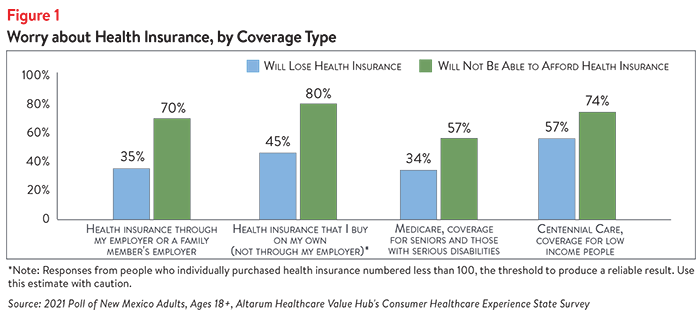
Worry about affording healthcare in the future also varied by ethnicity, income and location (see Table 1). Eighty-four percent of respondents who identify as Hispanic/Latino report experiencing any healthcare affordability worry, compared to 77% of non-Hispanic/Latino respondents. Worry about healthcare affordability varies slightly between New Mexican adults living in rural and non-rural communities—83% of rural residents and 78% of non-rural residents report experiencing one or more healthcare affordability worries in the past 12 months. While New Mexico adults across the income spectrum report similar levels of worry, those earning less than $50,000 are most likely to worry about affording coverage and care.
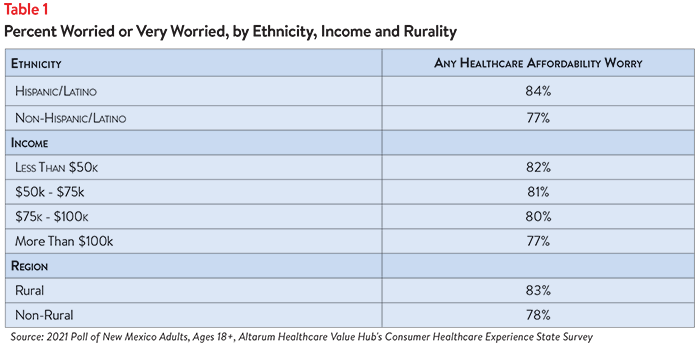
Worries about losing health insurance and health insurance becoming unaffordable are also more prevalent among certain groups of New Mexico residents. For instance, 45% of those earning less than $50,000 a year worry about losing their health insurance, compared to 24% of those earning more than $100,000 per year (see Table 2). It is interesting to note, however, that a relatively similar percentage of respondents at all income levels worry about health insurance becoming too expensive. In addition, Hispanic/Latino residents are more likely than non-Hispanic/Latino residents to report worrying about both losing health insurance and health insurance becoming unaffordable.
Differences in Healthcare Affordability Burdens
The survey also revealed differences in how New Mexico adults experience healthcare affordability problems.
Affordability problems affect families quite far up the income ladder, with more than half (53%) of residents earning $100,000 or more struggling to afford some aspect of coverage or care in the past 12 months (see Figure 2). New Mexico residents earning less than $50,0003 experience the greatest burden, with 73% reporting affordability problems.
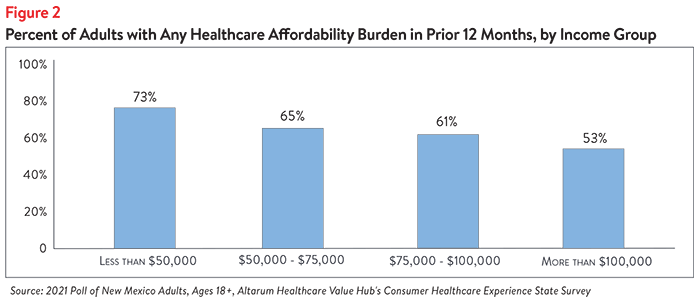
Additionally, New Mexicans living in rural communities are more likely to report healthcare affordability burdens than non-rural residents, likely contributing to higher rates of forgoing needed care (see Figure 3). Sixty-six percent of rural residents report having gone without care in the past year, compared to 53% of non-rural residents. Additionally, almost half (43%) of rural adults report either not filling a prescription, cutting pills in half or skipping a dose of medicine due to cost concerns in the prior 12 months, compared to 24% of non-rural adults (see Table 3).
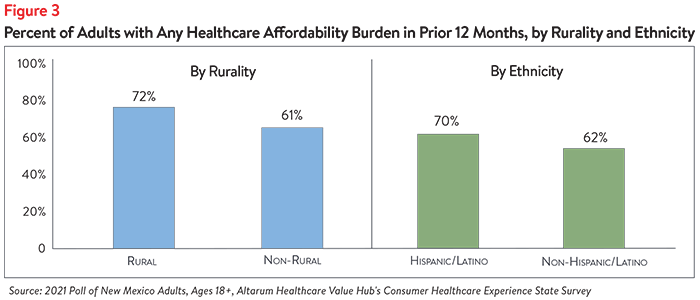

New Mexicans who identify as Hispanic or Latino are also more likely to report healthcare affordability burdens than those identifying with other ethnic groups (see Figure 3). Sixty-three percent of Hispanic/Latino New Mexicans report having gone without care due to cost concerns in the past year, compared to 55% of non-Hispanic/Latino residents.

While residents earning less than $50,000 per year most frequently report skipping and rationing due to cost, this behavior is common across the income spectrum. Almost half (48%) of residents earning $100,000 or more report forgoing care due to cost and nearly one-third (29%) have taken medication differently than prescribed. Even larger percentages of respondents in other income groups report having taken these actions in the past 12 months, indicating that the problem is widespread.
COVID Worries
In addition to affordability worries, New Mexico residents were asked about their top worries related to the COVID crisis.4 When asked about “affording treatment of coronavirus/COVID-19 if you need it,” 60% of respondents reported being somewhat or very worried.
Separately, out of twelve possible responses, respondents were asked to pick the top three things they were most worried about with respect to COVID-19 (see Table 4). Twenty-eight percent of respondents identified affording COVID-19 treatment as one of their top three concerns.
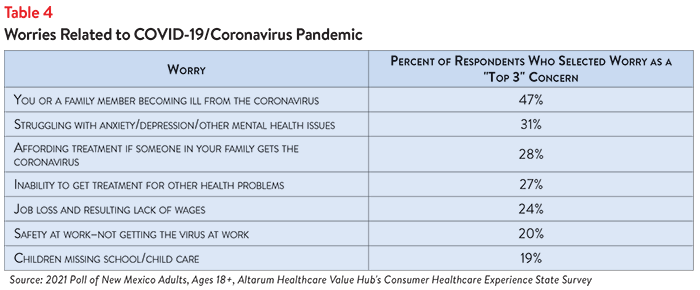
In smaller numbers, New Mexico adults worry about many other issues, including: decreased value of retirement savings (18%); job loss and resulting loss of health coverage (18%); ability to vote safely (11%); and unavailability of COVID treatment if they or a family member gets sick (10%).
Though the increased availability of COVID-19 vaccines may have somewhat lessened worries surrounding the virus, it is important to note that 3 in 5 respondents (60%) remain somewhat or very worried about affordability related to COVID-19.
Dissatisfaction with the Health System and Support for Change
In light of their healthcare affordability and COVID concerns, it is not surprising that New Mexico residents are extremely dissatisfied with the health system. Statewide:
- Just 25% agreed or strongly agreed that “we have a great healthcare system in the U.S.,”
- While 69% agreed or strongly agreed that “the system needs to change.”
To investigate further, the survey asked about both personal and governmental actions to address health system problems.
Personal Actions
New Mexico adults see a role for themselves in addressing healthcare affordability. Survey respondents reported specific actions they have already taken, like researching the cost of a drug beforehand (58%), as well as actions they should be taking—79% said they would switch from a brand to a generic drug if given a chance.
When asked to select the top three personal actions that would be most effective in addressing healthcare affordability (out of ten options), the most common responses were:
- 66%—Take better care of my personal health
- 40%—Research treatments myself, before going to the doctor
- 38%—Write or call my STATE representative asking them to take action
- 33%—Write or call my FEDERAL representative asking them to take action
Government Actions
But far and away, New Mexico residents see government as the key stakeholder that needs to act to address health system problems. Moreover, addressing healthcare problems is a top priority that New Mexico residents want their elected representatives to work on.
At the beginning of the survey, respondents were asked what issues the government should address in the upcoming year. The top vote getters were:
- 59%—Healthcare
- 55%—Economy/Joblessness
- 37%—Environment/Energy
When asked about the top three healthcare priorities the government should work on, the top vote getters were:
- 49%—Address high healthcare costs, including prescription drugs
- 38%—Preserve consumer protections preventing people from being denied coverage or charged more for having a pre-existing medical condition
- 33%—Get health insurance to those who cannot afford coverage
Of more than 20 options, New Mexico adults believe the reason for high healthcare costs is unfair prices charged by powerful industry stakeholders:
- 70%—Drug companies charging too much money
- 68%—Hospitals charging too much money
- 65%—Insurance companies charging too much money
When it comes to tackling costs, respondents endorsed a number of strategies, including:
- 93%—Show what a fair price would be for specific procedures
- 91%—Make it easy to switch insurers if a health plan drops your doctor
- 89%—Ensure the cost of widely needed vaccines are affordable for all
- 89%—Require insurers to provide up-front cost estimates to consumers
- 87%—Require hospitals and doctors to provide up-front cost estimates to consumers
There were also high levels of support for strategies to lower prescription drug costs:
- 91%—Require drug companies to provide advance notice of price increases and information to justify those increases
- 90%—Set standard prices for drugs to make them affordable
- 90%—Prohibit drug companies from charging more in the U.S. than abroad
- 89%—Authorize the Attorney General to take legal action to prevent price gouging or unfair prescription drug price hikes
- 88%— Expand health insurance options so that everyone can afford quality coverage
- 88%— Set standard payment to hospitals for specific procedures
Support for Action Across Party Lines
There is also remarkable support for change regardless of respondents’ political affiliation (see Table 5).
Policies to Address COVID Concerns
In addition to their views on the policies and approaches above, respondents were asked about support for and against policies related to the COVID crisis. Out of eleven possible responses, respondents were asked to pick the top three policies that would help address COVID-related problems. There was significant diversity in the policies supported, with the highest percentages of respondents selecting “Universal health coverage for all” and “Improved public health emergency preparedness” as a top three priority (see Table 6).

The next most supported policies—“Additional Federal stimulus payments” and “More financial help for small businesses”—received similar levels of support. “More financial help for large businesses” received the least support, as it was a priority for only a small percentage of respondents.
Conversely, when respondents were asked about which policies they did NOT support, 36% indicated that they did not support “More financial help for large businesses.” Trailing behind that (with 24% of respondents selecting) was “Universal health coverage for all,” although a higher percentage of respondents indicated support. In this area, there was a lack of agreement across party lines, with Republicans far more likely to NOT support “Universal health coverage for all” as a means to address COVID-19 concerns, compared to Democrats and those not affiliated with either party (see Table 7).

It is important to note, however, that when asked generically about “Expanding health insurance options so that everyone can afford quality coverage,” 88% of respondents agreed or strongly agreed with this policy as a means of improving affordability, with high levels of support across party lines. When asked about the policies they did NOT support, respondents were given the option of selecting “I support all of the policies listed.” Thirty-one percent of respondents selected this option.
The high burden of healthcare affordability, along with high levels of support for change, suggest that elected leaders and other stakeholders need to make addressing this consumer burden a top priority. Moreover, the current COVID crisis is leading state residents to take a hard look at how well health and public health systems are working for them, with strong support for a wide variety of actions. Annual surveys can help assess whether or not progress is being made.
Notes
1. N.M. Pandemic Restrictions Gone July 1, Office of the Governor of New Mexico, press release (June 18, 2021). Available at: https://www.governor.state.nm.us/2021/06/18/n-m-pandemic-restrictions-gone-july-1/.
2. Of the current 33% of New Mexico adults who encountered one or more cost-related barriers to getting healthcare during the prior 12 months, 22% did not fill a prescription, while 24% cut pills in half or skipped doses of medicine due to cost.
3. Median household income in New Mexico was $49,754 (2015-2019). U.S. Census, Quick Facts. Retrieved from: U.S. Census Bureau QuickFacts: New Mexico
4. COVID-19 is the disease caused by the coronavirus, which was characterized as a pandemic by the World Health Organization on March 11, 2020. For a comparison of how respondents from Connecticut, Kentucky, Mississippi and New Jersey answered our COVID questions, please see Healthcare Value Hub, How COVID Has Shaped Residents’ Broader Attitudes Towards the Health System, Data Brief No. 86.
Methodology
Altarum’s Consumer Healthcare Experience State Survey (CHESS) is designed to elicit respondents’ unbiased views on a wide range of health system issues, including confidence using the health system, financial burden and views on fixes that might be needed.
The survey used a web panel from Dynata with a demographically balanced sample of approximately 1,250 respondents who live in New Mexico. The survey was conducted in English or Spanish and restricted to adults ages 18 and older. Respondents who finished the survey in less than half the median time were excluded from the final sample, leaving 1,170 cases for analysis. After those exclusions, the demographic composition of respondents was as follows, although not all demographic information has complete response rates:
